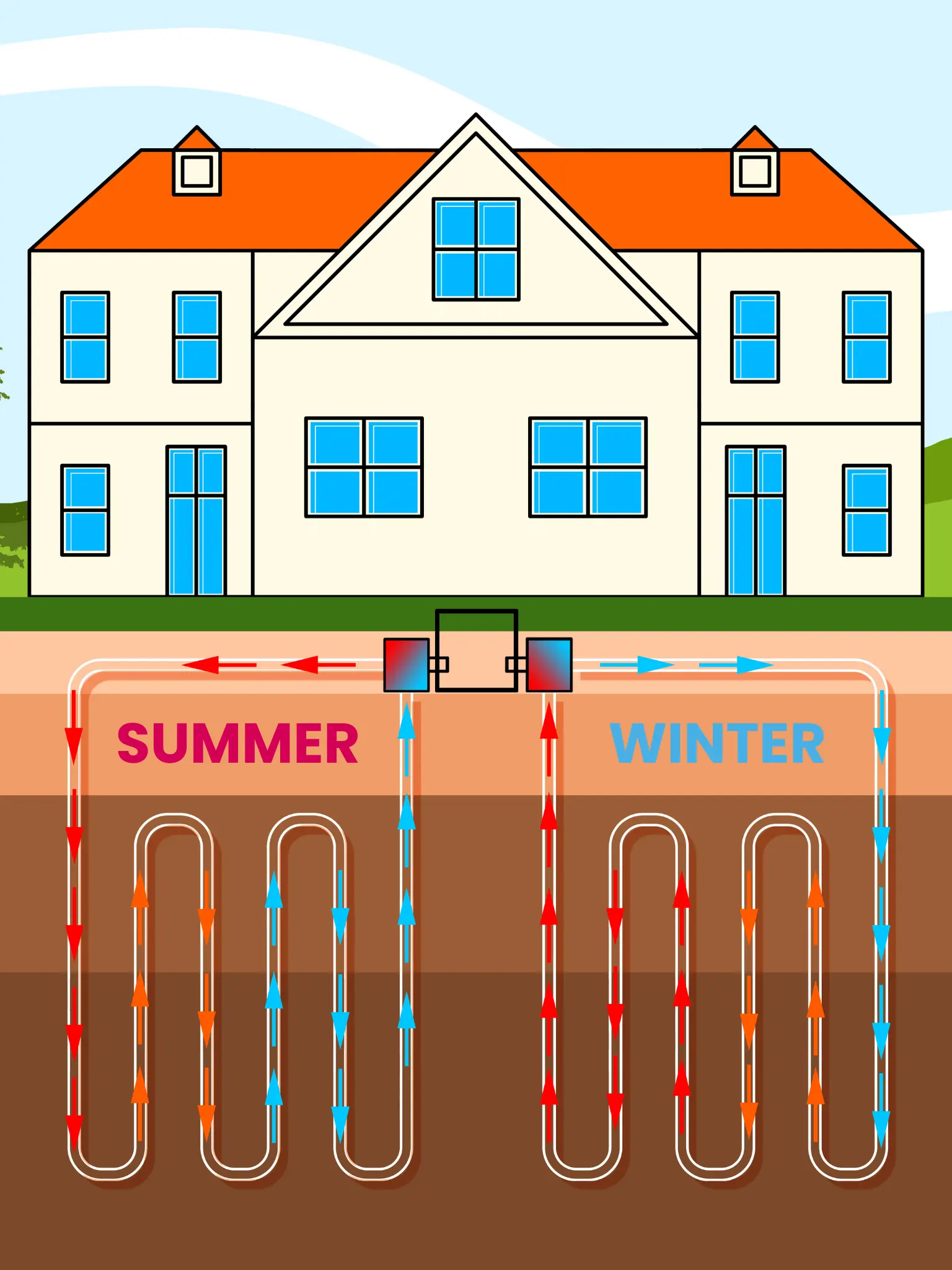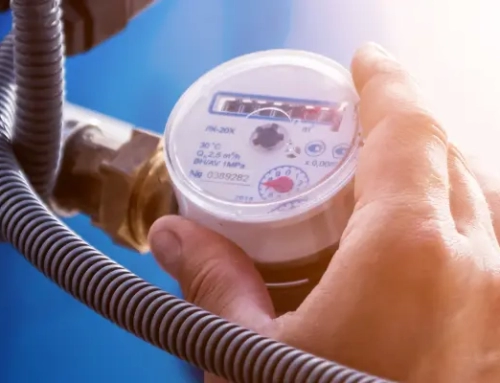Ground source heat pumps: a comprehensive guide for businesses

In today’s world, sustainability isn’t just a buzzword – it’s a necessity. With energy costs fluctuating and environmental concerns growing, business owners are increasingly searching for efficient, eco-friendly solutions.
Enter ground source heat pumps (GSHPs). These clever systems are revolutionising how businesses heat their premises while promoting sustainability. In this blog post, we’ll explore the ins and outs of GSHPs, their benefits, and why they could be a game-changer for your business.
What are ground source heat pumps?
Ground source heat pumps are a type of renewable energy technology used to heat and cool buildings. Unlike traditional heating systems that burn fuel, GSHPs use the stable temperatures found underground to regulate indoor climates.
Nearly half of the sun’s energy is absorbed by the Earth’s surface, making ground source heat pumps an excellent renewable and sustainable resource for capturing thermal energy. As a result, they’re an incredibly efficient option for business owners looking to reduce energy costs and their carbon footprint.
By investing in GSHPs, businesses not only contribute to a healthier planet but also benefit from significant energy savings. Imagine running your operations with a system that’s not only cost-effective but also aligns with global sustainability goals. Sounds like a win-win, right?
In this post, we’ll break down how ground source heat pumps work, their installation process, costs, and more. By the end, you’ll have a clear understanding of why GSHPs could be the perfect fit for your business.
How do ground source heat pumps work?
Ground source heat pumps operate on a simple yet effective principle. They transfer heat from the ground into buildings during the winter and reverse the process in the summer to provide cooling. Here’s how they achieve this:
The technology explained
The system consists of three main components: ground loops, a heat pump unit, and a distribution system. Ground loops are pipes buried underground, usually in horizontal trenches or vertical boreholes. These pipes circulate a mixture of water and antifreeze, which absorbs heat from the ground.
The heat pump unit then extracts this heat and compresses it to a higher temperature, which can be used for heating. During warmer months, this process is reversed, and the heat pump removes heat from the building, dispersing it back into the ground.

Efficient & versatile
What makes GSHPs stand out is their efficiency. The constant temperature of the ground makes these systems highly reliable and efficient, regardless of seasonal weather changes. Businesses can enjoy a consistent indoor climate without the high energy costs associated with traditional heating and cooling methods.
Integrated systems
The environmental & economic benefits of GSHPs
1. Reduced carbon footprint
One of the most significant advantages of GSHPs is their low environmental impact. Since they use renewable energy from the ground, they produce far fewer greenhouse gases compared to fossil fuel-based systems. This reduction in carbon emissions can help businesses meet sustainability targets and contribute to global efforts to combat climate change.
2. Cost savings
While GSHPs require an initial investment, the long-term savings are impressive. Businesses can expect lower energy bills due to the system’s efficiency and reliance on renewable energy. Over time, these savings can offset the initial costs resulting in pure savings, making GSHPs a financially sound investment.
3. Enhanced property value
Installing a ground source heat pump can increase the value of your property. Energy-efficient buildings are increasingly in demand, and having a commercial heat pump can make your premises more attractive to potential buyers or tenants. Investing in an energy-efficient heater is a smart move that pays off in multiple ways.
Ground source heat pump installation: the process & considerations
The installation of a ground source heat pump involves several steps and considerations. Here’s what businesses need to know before taking the plunge:
Where can you install commercial GSHPs?
A commercial ground source heat pump can be installed in any commercial building, including offices, retail establishments, and factories. Such systems are particularly beneficial for industrial settings where high levels of heat are required for operational processes.
For large buildings, a cascaded GSHP system might be the ideal solution. This setup connects multiple heat pumps to deliver increased heating capacity, effectively catering to larger spaces such as factories or warehouses.
Site assessment
Before installation, a thorough site assessment is crucial. This involves evaluating the ground conditions, available space for ground loops, and the heating and cooling needs of the building. A professional installer will conduct this assessment to determine the best configuration for your property.
Installation process
The installation process typically involves drilling boreholes or digging trenches for the ground loops. Once the loops are in place, they’re connected to the heat pump unit inside the building. This unit is then linked to the distribution system, such as radiators or underfloor heating.
Fortunately, the majority of the work needed to install a ground source heat pump occurs outdoors or in areas away from your staff and customers. This ensures minimal disruption to your business operations compared to other heating and cooling systems.
Long-term considerations
It’s important to consider the long-term aspects of GSHPs, including maintenance. While there is an initial investment and setup required, the benefits far outweigh the temporary inconvenience. Proper installation by a professional and regular maintenance will ensure the system’s longevity and efficiency, providing reliable heating and cooling for years to come.

Understanding the cost of ground source heat pumps
Cost is a critical factor for any business investment, particularly in this case as you’ll want to work out your return on investment (ROI). Here, we’ll break down the costs associated with ground source heat pumps and what you can expect:
Initial investment
The initial cost of a GSHP system includes the price of the equipment, installation, and any necessary modifications to the building. This can range from £10,000 to £30,000 or more, depending on the size and complexity of the installation. While this may seem steep, the long-term savings and benefits often justify the upfront expense.
Running costs
Once installed, GSHPs have relatively low running costs. They use electricity to operate but at a much lower rate compared to conventional heating systems. Businesses can see significant reductions in their energy bills, especially if they switch from oil or gas heating.
Financial incentives
The UK government offer a range of financial incentives to encourage the adoption of renewable energy technologies. These can include grants, tax credits, and rebates that help offset the initial investment. We’ll explore these incentives in more detail later in the post.
Ground source heat pump efficiency & maintenance tips
To get the most out of your ground source heat pump system, it’s essential to focus on efficiency and maintenance. Here’s how to ensure your GSHP operates at peak performance:
Maintain your system regularly
Regular maintenance is key to the longevity and efficiency of your GSHP. This includes checking the ground loops, heat pump unit, and distribution system for any issues. Much like your boiler at home, having a professional service once a year can prevent problems and keep the system running smoothly.
Optimise its performance
There are several ways to optimise the performance of your GSHP. Ensure that your building is well-insulated to reduce heat loss. Adjust the temperature settings to match occupancy patterns, and consider integrating smart controls for better efficiency.
Monitor & adjust where necessary
Keep an eye on your system’s performance and energy consumption. Monitoring tools can provide valuable insights into how the system is operating and highlight areas for improvement. Regularly reviewing and adjusting the settings can lead to significant energy savings.
Government incentives & support for commercial GSHPs
The UK government is supporting the transition to renewable energy through various incentives. Here’s what businesses should know about the support available for ground source heat pumps:
Financial incentives
Financial incentives can significantly reduce the cost of installing a GSHP. These may include grants, rebates, and tax credits. At the time of writing, there aren’t any grants, rebates or credits available, however the government has set stringent targets to achieve its Net Zero by 2050 goal, so it’s worth consulting a professional who can let you know about any changes.
Regulatory support
Beyond financial incentives, regulatory support can also play a role. The UK government are setting targets for renewable energy adoption and implementing policies that favour sustainable technologies. Staying informed about these regulations can help businesses plan their investments strategically.
Accessing support
Navigating the various incentives and support schemes can be complex. Working with a professional who understands the regulatory landscape can simplify the process. They can help identify the best options for your business and guide you through the application process.
Ground source heat pumps represent the future of sustainable heating for businesses. They offer a reliable, efficient, and eco-friendly alternative to traditional systems, with significant cost savings and environmental benefits.
By investing in GSHPs, business owners can take a proactive step towards sustainability, reduce energy costs, and enhance their property value. The support available from governments further sweetens the deal, making now the perfect time to consider this innovative technology.
Ready to explore how ground source heat pumps can transform your business? Talk to our team today to learn more and start your sustainability journey.





